Gennaro Cuofano's Blog, page 204
May 22, 2020
Reverse Engineering Tech Giants Business Models

In this video, I reverse engineer tech giants‘ business models by looking primarily at how they generate revenues. We’ll look at all the revenue generation strategies, how they overlap in some cases, how they complement in some others. And what we can learn, borrow, and apply back to our business.
[image error]
More videos:
Free Business CourseFree Financial Analysis Course
More free guides:
50 Successful Business ModelsDigital Business Models
The post Reverse Engineering Tech Giants Business Models appeared first on FourWeekMBA.
Mission Statement Examples: How To Write A Mission Statement
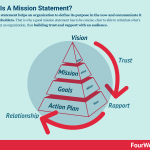
A mission statement helps an organization to define its purpose in the now and communicate it to its stakeholders. That is why a good mission statement has to be concise, clear to able to articulate what’s unique about an organization, thus building trust, and rapport with an audience.
Why does a mission statement matter?
Business isn’t done for the sake of it. Of course, making money is a crucial element of making business, but an organization also exists to create a culture and push its core values and beliefs into the world. Therefore, a company’s purpose is as important if not more of how it decides to make money.
Therefore a mission statement is a great way to define a brand purpose and communicate it outside the organization although the brand purpose and mission statement is not the same thing.
In the 2018 Deloitte Millennial Survey Report, it shows that millennials (people born from 1981 and become adult at the turn of the 21st century) in particular have lost faith in business.
As highlighted in the report “there continues to be a stark mismatch between what millennials believe responsible businesses should achieve and what they perceive businesses’ actual priorities to be” and if that is not enough three-quarters of the responders “see businesses around the world focusing on their own agendas rather than considering the wider society.”
This brings us back to why a mission-oriented organization has become so important. As the same report shows “good pay and positive cultures are most likely to attract both millennials and Gen Z, but diversity/inclusion and flexibility are important keys to keeping them happy.“
Therefore, a company’s purpose can help the organization better alight with its customers, and employees, but also with its other main stakeholders (owners, and suppliers).
Do you need to have a mission statement?
As the mission statement helps define and communicate the goals of the organization, it also helps align its interests with those of employees and customers. While a larger an organization the more it might need a mission statement. A mission statement can help startups and small organizations create a strong identity.
Therefore there might be three key elements that make a mission statement important:
Alignment
Culture
Action
Mission statement vs. vision statement
It is important not to confuse a mission with a vision statement. In a vision statement, an organization can set its long-term goals. For instance in BHAG (big hairy audacious goal), Jim Collins points out:
Like the moon mission, a trueBHAGis clear and compelling and serves as a unifying focal point of effort– often creating immense team spirit. It has a clear finish line, so the organization can know when it has achieved the goal; people like to shoot for finish lines.
ABHAGengages people– it reaches out and grabs them in the gut. It is tangible, energizing, highly focused. People “get it” right away; it takes little or no explanation.
Thus a well-drafted vision reflects a long-term – seemingly unachievable – goal. At Google, they call it Moonshot Thinking. As it is so far into the future, it might also be easier to draft.
A mission statement instead has to be specific, actionable, and easy to understand to anyone within the organization, and from the outside world! It is a way to set the stage for action in the present moment.
Simple, isn’t it?
SMART: How to draft objectives from a mission statement
The objective of a well-crafted mission statement is to set goals that need to be achieved in the short and medium-term. Those goals need to be communicated clearly to the key stakeholders.
That’s why a good mission statement is clear, concise, and able to communicate the uniqueness of the organization in the market place.
Drafting a good mission statement isn’t a simple exercise as you need to go deep and define your purpose. You need to ask questions like: what do we do? Why do we do it? How do we do it differently? Whom do we do it for? And what key values do we bring that others don’t?
Therefore, from a well-crafted mission statement key objectives, can be derived. You can use several frameworks to draft a mission statement’s objectives. For the sake of this discussion, we’ll use the S.M.A.R.T. method.
As pointed out by George T. Doran in a paper entitled “There is a S.M.A.R.T. way to write management’s goals and objective:“
A characteristic of management excellence is a climate in which company officers and managers talk in terms of objectives.
He defined objectives as:
Quantitative support and expression to management’s beliefs.
He recognized that objectives enabled organizations to “focus on problems, and give the company a sense of direction.” Yet he also recognized executives couldn’t define meaningful objectives.
For that matter, it went on to create a framework on how to define meaningful objectives. It had to be:
Specific – target a specific area for improvement.
Measurable – quantify or at least suggest an indicator of progress.
Achievable – specify who will do it.
Realistic – state what results can realistically be achieved, given available resources.
Time-related – specify when the result(s) can be achieved.
In defining the objectives for your mission statement, also a tool like the OKR can be a good companion:
[image error]
Read: OKR Goal-Settign System
How to draft your mission statement
Not everyone agrees on how a great mission statement should look like. I believe that a good mission statement has to have five key elements:
Focused: it needs to get you toward your vision
Actionable: it needs to set things in motion
Achievable: it has to be actionable but also don’t lose sight of the long-term vision
Motivational: it has to motivate people to take action
Unique: you need to be able to distinguish your organization from the others
In other words, while you define a key and actionable objective. This objective is what in the now will get you going to get you closer to achieve the vision set 10 ahead from now. Therefore, it is important to ask what actions you’re doing today will bring you closer to your vision.
You also need to make it achievable. Indeed, most people think that to make people act you have to set reasonable goals. That isn’t always the case. Indeed, the so-called 10X goal-setting might make your organization more successful than a regular goal-setting schedule.
However, we’ll leave the big hairy audacious goal to the vision statement. While, we’ll let the mission statement be more realistic, as it needs to set things in motion.
In other words, where a vision statement has to be inspirational, a mission statement has to be motivational.
In terms of structure, an opener like “Our mission is to…” followed by an adverb or a verb that makes it actionable “build the …” an adjective and noun that indicate the uniqueness of that mission “leading product…” and a closer that defines its uniqueness might work pretty well.
Of course, this is one example; let’s look at some of the mission statements out there.
Mission statement examples
Let’s analyze some of the mission statements of companies that influence our daily lives. It is important to remark that in no way I’m trying to say that a mission statement correlates with a company’s success.
A mission statement is a tool that well-drafted can serve as a way to focus on the actions of groups of people within the organization. It also helps in creating an identity and culture within the organization. Whether or not that determines the success of a company it’s not possible to determine, in my opinion.
Indeed, we’ll see how very successful companies set out mission statements that on paper might see entirely off, and we’ll start from Google’s mission statement.
Amazon Mission Statement
[image error]
While Amazon’s mission statement is to “serve consumers through online and physical stores and focus on selection, price, and convenience” and its vision is “to be Earth’s most customer-centric company, where customers can find and discover anything they might want to buy online, and endeavors to offer its customers the lowest possible prices.”
In reality, this applies to Amazon intended as an e-commerce company. Yet Amazon has a sort of multi-business model where in the same company we have a few parts of the business that have completely different features.
You can grasp the complexity of Amazon business model in this map:
[image error]
In short, while the core of Amazon’s business is still its e-commerce platform. Amazon also has other parts (like Amazon AWS) that have different logic.
For instance, AWS isn’t a B2C business but rather a B2B/Enterprise Cloud Platform, driven by a community of developers, building AI tools, and SMBs and enterprise companies as paying customers (Netflix, for instance, is an AWS customer).
In short, Amazon has a suite of value propositions, each serving several key players that sustain the business:
[image error]
Read: Amazon Mission Statement
Apple Mission Statement
[image error]
Apple’s mission is “to bringing the best user experience to its customers through its innovative hardware, software, and services.” In a manifesto dated 2009 Tim Cook set the vision specified as “We believe that we are on the face of the earth to make great products and that’s not changing.”
[image error]
Just like Amazon, Apple is a tech giant, and as such, it encompasses a set of value propositions that make Apple’s brand recognized.
Read: Apple Mission Statement
Coca-Cola Mission Statement
[image error]
Coca-Cola is very good at marketing itself. By setting up its product as delivering a specific positive emotion for people that consume it has two effects, I argue
Empower its employees by making them feel they are making a difference in people’s lives, thus offering them a different perspective of just a company “selling sugary water” (remember when Steve Jobs said to Pepsi executive John Sculley “Do you want to sell sugar water for the rest of your life, or do you want to come with me and change the world?”)
Allowing its consumers to align with this view of the Coca-Cola brand
Google Mission Statement
[image error]
[image error]
Google‘s mission statement doesn’t sound too far from a vision statement. Indeed, Google is the leading source of the world’s information. However, this same mission was set out by Google’s founders back in the days when Google was still a small startup.
I think at the time when people did read this mission they thought of it as too ambitious for a company that at the time was not a key player in the search industry. Yet this is at the core of Google‘s Moonshot Thinking. And this mission helped for sure the company to focus on a key long term objective, that they indeed achieved!
I’m sure out there is plenty of organizations, now dead, that had very ambitious goals. However, I do think that a very ambitious goal is part of a good mission statement.
Read: Google’s Mission Statement
Microsoft Mission Statement
[image error]
Microsoft’s mission statement is also very generic (every person and every organization on the planet) and it didn’t set a specific goal (achieve more of what?). I don’t think that is a good example.
By itself the verb “empower” doesn’t mean much if not specified for whom. One thing is to say, “empower young men wanting to advance their careers.” Another is to say “empower every person.”
Read: Microsoft Mission Statement
McDonald’s Mission Statement
[image error]
This is a great mission statement. It is specific, it defines well its goal, and it also identifies a plan to get there through the five Ps:
People
Products
Place
Price
And promotion
It is not time-constrained as this is an ongoing objective.
Netflix Mission Statement
[image error]Netflix’s core mission, strategy, and vision are that of “improving its members’ experience by expanding the streaming content with a focus on a programming mix of content that delights members and attracts new members.”
Read: Netflix Mission Statement
Starbucks Mission Statement
[image error]
Starbucks highlights its mission as “to inspire and nurture the human spirit – one person, one cup and one neighborhood at a time.” And its vision is to “treat people like family, and they will be loyal and give their all.”
[image error]
Starbucks is a global consumer brand with direct distribution, recognized brands, and products that make it a viable business. Its reliance on the Americas as a primary operating segment makes it a weakness. At the same time, Starbucks faces risks related to coffee beans price volatility. Yet the company still has global expansion opportunities.
[image error]
Starbucks is a retail company that sells beverages (primarily consisting of coffee-related drinks) and food. In 2018, Starbucks had 52% of company-operated stores vs. 48% of licensed stores. The revenues for company-operated stores accounted for 80% of total revenues, thus making Starbucks a chain business model.
Read: Starbucks Mission Statement
Tesla Mission Statement
[image error]Tesla’s vision is to “create the most compelling car company of the 21st century by driving the world’s transition to electric vehicles,” while its mission is “to accelerate the advent of sustainable transport by bringing compelling mass-market electric cars to market as soon as possible.” Tesla used a transitional business model as its ecosystem grows.
Read: Tesla Mission Statement
Uber Mission Statement
[image error]
Our mission is to ignite opportunity by setting the world in motion.
The ambition of Uber’s business strategy emphasized first on creating a whole new market (ridesharing). And then to take over the mobility market itself.
As pointed out in its financial prospectus Uber “just got started” with only 2% of the population in the 63 countries where it operates the company looks to expand further.
Several factors drove the Uber phenomenon. In the letter to shareholders in 2019, CEO Dara Khosrowsha pointed out how Uber got there and where’s going next!
Walmart Mission Statement
[image error]
Walmart’smission can be summarized as “helping people around the world save money and live better – anytime and anywhere – in retail stores and through eCommerce.” While its vision is to “make every day easier for busy families.” Walmart defines “busy families” as the bull’s eye of its business strategy.
Read: Walmart Mission Statement
WeWork Mission Statement
[image error]
WeWork’s mission is “to elevate the world’s consciousness.”
Read: WeWork Mission Statement
Summary and conclusions
As we can see from the examples above, drafting a good mission statement isn’t a simple task. And as a mission statement becomes universal, it also risks losing its specificity and becomes too generic with no utility.
I believe that a good mission statement should in the first place allow an organization to align a group of people with focusing on the same objective while getting them inspired.
Of course, a mission statement has to be accompanied by specific plans, and it needs to be executed daily to become effective over time!
However, from the mission statement, a set of core values can be derived. Those core values will be the guiding principles of the organization.
Read next:
Amazon Mission Statement and Vision Statement In A Nutshell
Apple Mission Statement and Vision Statement In A Nutshell
Google Mission Statement and Vision Statement In A Nutshell
A Quick Glance At Uber Mission Statement
Walmart Mission Statement and Vision Statement In A Nutshell
Nike Mission Statement and Vision Statement In A Nutshell
Microsoft Mission Statement In A Nutshell
Other resources:
53 Successful Types of Business Models You Need to Know
Business Strategy: Definition, Examples, And Case Studies
Business Model Canvas Explained
Blitzscaling Business Model Innovation Canvas In A Nutshell
What Is a Value Proposition? Value Proposition Canvas Explained
What Is a Lean Startup Canvas? Lean Startup Canvas Explained
What Is Market Segmentation? the Ultimate Guide to Market Segmentation
Marketing Strategy: Definition, Types, And Examples
What is a good mission statement?
A mission statement helps an organization to define its purpose in the now and communicate it to its stakeholders. That is why a good mission statement has to be concise, clear and able to articulate what’s unique about an organization.
What is Alphabet’s mission statement?
Google mission statement is to “organize the world’s information and make it universally accessible and useful.” Its vision statement is to “provide an important service to the world-instantly delivering relevant information on virtually any topic.” In 2019, Sundar Pichai emphasized a renewed mission to allow people “to get things done!”
View more on FourWeekMBA
What is Starbucks mission statement?
Starbucks highlights its mission as “to inspire and nurture the human spirit – one person, one cup and one neighborhood at a time.” And its vision is to “treat people like family, and they will be loyal and give their all.”
View more on FourWeekMBA
What is Apple mission statement?
Apple Mission is “to bringing the best user experience to its customers through its innovative hardware, software, and services.” And in a manifesto dated 2009 Tim Cook set the vision specified as “We believe that we are on the face of the earth to make great products and that’s not changing.”
View more on FourWeekMBA
What is Nike mission statement?
Nike vision is “to bring inspiration and innovation to every athlete in the world.” While its mission statement is to “do everything possible to expand human potential. We do that by creating groundbreaking sport innovations, by making our products more sustainably, by building a creative and diverse global team and by making a positive impact in communities where we live and work.”
View more on FourWeekMBA
What is Amazon mission statement?
Amazon mission statement is to “serve consumers through online and physical stores and focus on selection, price, and convenience.” Amazon vision statement is “to be Earth’s most customer-centric company, where customers can find and discover anything they might want to buy online, and endeavors to offer its customers the lowest possible prices.”
View more on FourWeekMBA
The post Mission Statement Examples: How To Write A Mission Statement appeared first on FourWeekMBA.
May 21, 2020
Business Tech News – May 21

This session is dedicated primarily to e-commerce wars, core changes to Google core algorithms, and why it matters to its business model, acquisitions throughout the pandemic. Partnerships in the e-commerce space and how new social media formats are coming along:
Amazon vs. Google: https://fourweekmba.com/google-vs-amazon/ Google core update change: https://www.seroundtable.com/google-may-2020-core-update-live-29477.html Facebook Shops: http://about.fb.com/news/2020/05/introducing-facebook-shops/ Lessons in partnership marketing by Shopify: https://fourweekmba.com/partnership-marketing/ The Shopify-Facebook alliance: https://news.shopify.com/shopify-partners-with-facebook-to-help-businesses-launch-branded-facebook-shops Facebook acquisition of Giphy: https://about.fb.com/news/2020/05/welcome-giphy/ Joe Rogan podcast becomes a Spotify exclusive: https://www.theverge.com/2020/5/19/21263927/joe-rogan-spotify-experience-exclusive-content-episodes-youtube Clubhouse, the new app that with only 1500 users got a $100 million valuation: https://www.cnbc.com/2020/05/20/clubhouse-app-is-where-mc-hammer-and-jared-leto-chat-with-vcs.html
The post Business Tech News – May 21 appeared first on FourWeekMBA.
May 20, 2020
Amazon SWOT Analysis In A Nutshell
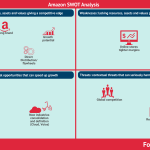
Amazon is among the most diversified business model in the tech industry. The company is well-positioned to dominate e-commerce further. And while its online stores have tight profit margins, Amazon still unlocks cash for growth, while consolidating its dominance in the cloud and grabbing new opportunities like voice.
Amazon strengths
[image error]Amazon has a diversified business model. In 2019 Amazon posted over $280 billion in revenues and over $11.5 billion in net profits. Online stores contributed to over 50% of Amazon revenues, followed by Physical Stores, Amazon AWS, Subscription Services, Third-party Seller Services, and Advertising revenues.
Strong brand: Amazon is the most valuable brand on earth. Launched as a bookstore, it eventually became the “everything store,” and from there, it dominated several other industries. Amazon today is exceptionally well-positioned to keep expanding its online stores’ capabilities. Diversified business model: Amazon is among the tech giants who have the most diversified business model. Spanning from e-commerce to cloud, advertising, and more.Massive growth potential: While Amazon passed the trillion-dollar in market capitalization, it is also positioned on several markets that might become trillion-dollar industries. Direct distribution/flywheels: Amazon enjoys massive flywheel effects thanks to its built-in growth mechanisms, which made it the company we know today.
[image error]The Amazon Flywheel or Amazon Virtuous Cycle is a strategy that leverages on customer experience to drive traffic to the platform and third-party sellers. That improves the selections of goods, and Amazon further improves its cost structure so it can decrease prices which spins the flywheel.
Amazon weaknesses
[image error]Amazon is a profitable company. Its operating income and net income passed $12.4 billion and $10 billion respectively in 2018. The operating income was driven primarily by Amazon AWS, contributing $7.29 billion. Amazon has been consistently profitable since 2015 when it posted 596 million in profits.
Online e-commerce has tighter margins: the online e-commerce side of Amazon has tighter profitability compared to other parts of the business. However, the same e-commerce is the platform around which the company has been developed. Thus, it needs to be judged based on cash flows.
Amazon threats
[image error]Google and Amazon are fighting for dominance between e-commerce and advertising.
Where Google has a monopoly in the search market. Amazon might gain a monopoly in product searches.
In 2020, Google opened its Google Shopping for free to contrast Amazon dominance on e-commerce and prevent Amazon from taking more space in the digital advertising industry, the core business fo Google.
Global competition and tech wars: As tech giants try to consolidate and keep the dominance in their industries, they also move in adjacent markets, thus overlapping part of their value proposition to consumers. This triggers expensive tech wars that might end up causing losses for Amazon as well.Regulation: Amazon has become a massive company made of many moving parts. This raises the question of whether it makes sense to break it up to prevent the company from abusing its dominant position in several industries (e-commerce, cloud voice).
Amazon opportunities
[image error]Amazon runs a platform business model as a core model with several business units within. Some units, like Prime and the Advertising business, are highly tied to the e-commerce platform. For instance, Prime helps Amazon reward repeat customers, thus enhancing its platform business. Other units, like AWS, helped improve Amazon’s tech infrastructure.
Global expansion: While Amazon has been growing at a crazy speed, its space for global expansion is still wide.New industries consolidation and definition: As Amazon expands, it also develops new markets. For instance, Amazon is a key player in the cloud industry. And it’s a dominant player in the voice industry, among the most interesting in the coming years.
[image error]In 2019, Alphabet’s (Google) Cloud Business was an almost $9 billion unit within Alphabet’s Google overall business model; to gain a bit of context; Microsoft intelligent cloud netted nearly $39 billion and Amazon AWS $35 billion in the same year.
Read more:
Amazon Business ModelWhat Is the Receivables Turnover Ratio? How Amazon Receivables Management Helps Its Explosive GrowthAmazon Case Study: Why from Product to Subscription You Need to “Swallow the Fish”What Is Cash Conversion Cycle? Amazon Cash Machine Business Model ExplainedWhy Is AWS so Important for Amazon Future Business Growth?Amazon Flywheel: Amazon Virtuous Cycle In A NutshellAmazon Value Proposition In A NutshellWhy Amazon Is Doubling Down On AWSThe Economics Of The Amazon Seller Business In A NutshellHow Much Is Amazon Advertising Business Worth?What Is the Cost per First Stream Metric? Amazon Prime Video Revenue Model ExplainedJeff Bezos Teaches You When Judgment Is Better Than Math And DataAlibaba vs. Amazon Compared in a Single InfographicAmazon Mission Statement and Vision Statement In A NutshellGoogle Vs. Amazon: The Latest Move For World DominationGoogle Q1 Profit 2020: Mobile Traffic, Youtube Ads, Youtube Memberships, And Cloud Saved The Day (For Now)Third-Party Sellers And Amazon’s Platform-First Business, Will It Last?
The post Amazon SWOT Analysis In A Nutshell appeared first on FourWeekMBA.
Facebook SWOT Analysis In A Nutshell
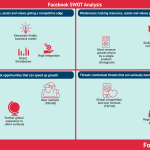
Facebook, with its products, with its strong appeal, and consumer brand has a solid business model, threatened in the last years by privacy concerns, which open up the way to potential regulation to break up the company. If that will not happen, Facebook will have the chance to expand to define other markets like VR.
Facebook strengths
[image error]Facebook is an attention-based business model. As such, its algorithms condense the attention of over 2.4 billion users as of June 2019. Facebook advertising revenues accounted for $31.9 billion or 98.66% of its total revenues. Facebook Inc. has a product portfolio made of Instagram, Messenger, WhatsApp, and Oculus.
Strong brand
Facebook Inc. has been able to build a strong consumer digital brand for its core products (Facebook) and the set of product parts of the holding group (Instagram, WhatsApp, Messenger, and Oculus going forward).
Strong products
Over the years, Facebook has undertaken an effective acquisition strategy, where it managed to buy products that would eventually become strong consumer brands (Instagram and WhatsApp). Those products today are still trendy and tied to the daily habits of hundreds of millions of people across the world.
High integration
Those same products are well integrated to form a whole Facebook ecosystem. For instance, Instagram advertising can be run directly from the Facebook Ads main platform, and WhatsApp might, in the future, also connect with that. Also, those products already share strategic parts that make the whole Facebook ecosystem highly integrated, even though the user is let free to experience each of those platforms separately.
Extremely viable business model
Facebook is among the most profitable companies on earth. With its mostly digital services, the company has built the strongest digital advertising machine (together with Google).
Direct distribution
Facebook also enjoys mostly a direct distribution, which is tied to the strength of its brands, as its apps are on top of mind for hundreds of millions of people they also traveled with a quick word of mouth mechanism, where people would download them as soon as bought a new mobile device. That made it easier for Facebook products to scale up.
Facebook weaknesses
[image error]ARPU or average revenue per user is a critical measure to assess Facebook ability to monetize its users. ARPU is given by total revenue in a given geography during a given quarter, divided by the average of the number of monthly active users in the geography at the beginning and end of the quarter.
Growth stalled in wealthier countries
As the mobile market (smartphones) saturates so does the ability of the growth of the Facebook products also slows down, especially in wealthier counties, where Facebook has reached a mature level. of penetration.
Most revenue growth is driven by a single product (Instagram)
Facebook successfully completed the transition to mobile a few years back, and that paid off. Indeed, today most of the advertising revenues come from mobile traffic, and from Instagram. This, however, also skewed Facebook revenues toward a single product and a single format, which opens up the way for competitors to compete.
[image error]
Facebook threats
[image error]GAFA is an acronym for Google, Apple, Facebook, and Amazon. Those companies emerged in the 2010s as the most powerful American tech companies.
Regulation and privacy
Facebook has been growingly under the radar of regulators as more privacy scandals have risen concerns about how the company handles the data and whether, after all, a business model that scaled to billions of users, can be based on advertising alone, and whether this would be in conflict of interests with the users‘ data, which is among the most valuable asset on Facebook. Facebook has already been fined for $5 billion dollars by the F.T.C. back in 2019, which while is the largest fine probably issued for users’ data breach, which represented just a bad quarter for Facebook, nothing more. Thus, the potential threat of regulation is on the potential breaking of the company and fines that can also pass the $5 billion mark.
Global competition and new formats (TikTok)
In the past decade when new formats came along Facebook was successful in acquiring them (Instagram) or replicating them (Snapchat). However, the rise of new formats, and companies like TikTok, raise the question on whether Facebook would be able at this time to contrast the growth of it, and if that might turn in a valid competitor eroding part of Facebook‘s market share. True though, that TikTok itself is opening up a new category, which might result in a market with a scale, even larger than what social media offered.
[image error]TikTok is the Chinese creative social media platform primarily driven by short-form video content. It launches challenges of various types to tap into the creativity of its users and generate engaging (if not addicting content) accessible via an infinite feed. TikTok primarily makes money through advertising, thus making it an attention-based business model.
Facebook opportunities
[image error]The digital advertising industry has become a multi-billion industry dominated by a few key tech players. While the industry advertising dollars are also fragmented across several small players and publishers across the web. Most of it is consolidated within brands like Google, YouTube, Facebook, Instagram, Amazon, Bing, Twitter, and Pinterest.
Further global expansion in other verticals
Facebook and its products have still the ability to expand in other verticals to make their products more and more engaging. For instance, during the pandemic, Facebook released on its products important updates about video chat, to enable more and more people to do all within the Facebook products. This makes it possible to improve further the engagement of those products.
New business models (payments platform)
Facebook is also integrating with its product payment frameworks that might enable the company to start collecting commission within its platform, thus enabling it to diversify its business model.
New markets (VR/AR)
Mark Zuckerberg is among the firmest believer in VR and the fact that the VR will be the next comprehensive tech platform. If that will be the case, this will open up much bigger market opportunities, as in the VR, the experience would be so comprehensive that Facebook would become much more than just an entertaining app, but it would convert into a Super Platform.
Read more: What Is A SWOT Analysis
Read next: Facebook Business Model, Facebook Way, Facebook Advertising Machine Explained
More resources:
50 Successful Types of Business Models You Need to KnowDigital Business Models MapBusiness Strategy: Definition, Examples, And Case Studies
The post Facebook SWOT Analysis In A Nutshell appeared first on FourWeekMBA.
May 19, 2020
Are You A Price Setter Or A Price Taker?
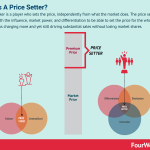
A price maker is a player who sets the price, independently from what the market does. The price setter is the firm with the influence, market power, and differentiation to be able to set the price for the whole market, thus charging more and yet still driving substantial sales without losing market shares.
Price setter vs. price taker
While the price setter influences the whole market, or it ignores it by charging premium prices without losing momentum in sales or losing market shares. On the other end, the price taker has to run behind the market, follow the trends, lower prices, just to keep up with sales momentum.
What makes the price setter different from the price taker?
Differentiation
The price setter isn’t just the dominant player in a category. Often it’s the player who has such a differentiated product, that nonetheless it charges premium prices it can still grow. Companies like Apple, Dyson, and Tesla are great examples.
They created a whole new category turned into a market itself (ex. Apple: smartphones, and tablets). And their brand is such a synonym with that category that they can retain market shares and still charge high prices.
Distribution
[image error]
The price setter also has a great control over distribution. A company like Apple has been able for years to charge premium prices on its iPhone because because beyond selling them in their stores, also sold them through indirect channels (carriers, cellular networks and more) who through financing also abated the cost of the device for average people, thus enabling a much wider number of people to purchase an otherwise too expensive device.
Read next:
What Is Business Model InnovationWhat Is a Business ModelWhat Is Business DevelopmentWhat Is Business StrategyWhat is BlitzscalingWhat Is Market SegmentationWhat Is a Marketing StrategyWhat is Growth Hacking
The post Are You A Price Setter Or A Price Taker? appeared first on FourWeekMBA.
SWOT Analysis Of Starbucks In A Nutshell
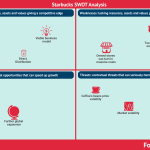
Starbucks is a global consumer brand with direct distribution, recognized brands, and products that make it a viable business. Its reliance on the Americas as a primary operating segment makes it a weakness. At the same time, Starbucks faces risks related to coffee beans price volatility. Yet the company still has global expansion opportunities.
Starbucks’ Strengths
Strong brand: across the globe Starbucks stores are the most recognized coffee shops in the world. With their blend of coffee, other products, and with its beautifully designed, yet standardized stores, Starbucks feels like a second home for many.A viable and proved business model: Starbucks has also a consolidated and viable business model which had the chance to grow organically in the last decades:Product and geographical diversification: Starbucks has been investing substantially in expanding its global operations. Thus, diversifying its revenue streams.Direct distribution: Thanks to its stores present in most cities across the globe, Starbucks enjoys a direct distribution channel with its customers.
[image error]Starbucks is a retail company that sells beverages (primarily consisting of coffee-related drinks) and food. In 2018, Starbucks had 52% of company-operated stores vs. 48% of licensed stores. The revenues for company-operated stores accounted for 80% of total revenues, thus making Starbucks a chain business model.
[image error]Starbucks highlights its mission as “to inspire and nurture the human spirit – one person, one cup and one neighborhood at a time.” And its vision is to “treat people like family, and they will be loyal and give their all.”
Starbucks’ Weaknesses
Operating income too dependent on the Americas: while Starbucks has been investing in diversifying its revenue streams across markets and geographies. It is still highly dependent on the financial performance of its Americas operating segment. Thus, if that will suffer the whole company viability might be jeopardized.Owned stores can turn in massive costs: the company runs a mix of owned and franchises stores, where the company-operated stores help the company keep the right mix, over franchised. This helps Starbucks control and keep a great customer experience. However, those stores can burn substantial resources when the economy slows down.
Starbucks’ Threats
The volatility of coffee’s price: cost of high-quality arabica coffee beans or other commodities can change swifty and it can also decreases in availability which can cause a disruption in the ability of Starbucks to serve its customers at the best.
Interruption of our supply chain could affect also the ability of Starbucks to keep operating its business at the best.Pandemic: The global pandemic has turned already in a huge threat for the company who will need to redefine part of its value chain in the coming years.
Starbucks’ Opportunities
Further global expansion: Starbucks is still among the most recognized brands in the world. As such, it still has a big potential of global expansion, which can enable the company to further grow.
Read next: Starbucks Business Model
Read more: What Is A SWOT Analysis
More resources:
50 Successful Types of Business Models You Need to KnowDigital Business Models MapBusiness Strategy: Definition, Examples, And Case Studies
The post SWOT Analysis Of Starbucks In A Nutshell appeared first on FourWeekMBA.
Business Frameworks To Keep In Your Strategic Toolbox
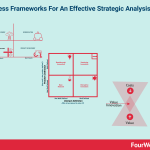
Ansoff Matrix
[image error]You can use the Ansoff Matrix as a strategic framework to understand what growth strategy is more suited based on the market context. Developed by mathematician and business manager Igor Ansoff, it assumes a growth strategy can be derived by whether the market is new or existing, and the product is new or existing.
Innovation Matrix
[image error]
Value Innovation
[image error]A blue ocean is a strategy where the boundaries of existing markets are redefined, and new uncontested markets are created. At its core, there is value innovation, for which uncontested markets are created, where competition is made irrelevant. And the cost-value trade-off is broken. Thus, companies following a blue ocean strategy offer much more value at a lower cost for the end customers.
Business Model Canvas
[image error]The business model canvas is a framework proposed by Alexander Osterwalder and Yves Pigneur in Busines Model Generation enabling the design of business models through nine building blocks comprising: key partners, key activities, value propositions, customer relationships, customer segments, critical resources, channels, cost structure, and revenue streams.
PESTEL Analysis
[image error]The PESTEL analysis is a framework that can help marketers assess whether macro-economic factors are affecting an organization. This is a critical step that helps organizations identify potential threats and weaknesses that can be used in other frameworks such as SWOT or to gain a broader and better understanding of the overall marketing environment.
SWOT Analysis
[image error]A SWOT Analysis is a framework used for evaluating the business’s Strengths, Weaknesses, Opportunities, and Threats. It can aid in identifying the problematic areas of your business so that you can maximize your opportunities. It will also alert you to the challenges your organization might face in the future.
Gap Analysis
[image error]A gap analysis helps an organization assess its alignment with strategic objectives to determine whether the current execution is in line with the company’s mission and long-term vision. Gap analyses then help reach a target performance by assisting organizations to use their resources better. A good gap analysis is a powerful tool to improve execution.
Porter’s Five Forces
[image error]Porter’s Five Forces is a model that helps organizations to gain a better understanding of their industries and competition. Published for the first time by Professor Michael Porter in his book “Competitive Strategy” in the 1980s. The model breaks down industries and markets by analyzing them through five forces
The post Business Frameworks To Keep In Your Strategic Toolbox appeared first on FourWeekMBA.
May 18, 2020
Nine Simple Strategy Frameworks To Grow Your Business
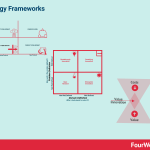
Porter’s Five Forces
[image error]Porter’s Five Forces is a model that helps organizations to gain a better understanding of their industries and competition. Published for the first time by Professor Michael Porter in his book “Competitive Strategy” in the 1980s. The model breaks down industries and markets by analyzing them through five forces
Ansoff Matrix
[image error]You can use the Ansoff Matrix as a strategic framework to understand what growth strategy is more suited based on the market context. Developed by mathematician and business manager Igor Ansoff, it assumes a growth strategy can be derived by whether the market is new or existing, and the product is new or existing.
Blitzscaling Canvas
[image error]The Blitzscaling business model canvas is a model based on the concept of Blitzscaling, which is a particular process of massive growth under uncertainty, and that prioritizes speed over efficiency and focuses on market domination to create a first-scaler advantage in a scenario of uncertainty.
Business Analysis Framework
[image error]Business analysis is a research discipline that helps driving change within an organization by identifying the key elements and processes that drive value. Business analysis can also be used in Identifying new business opportunities or how to take advantage of existing business opportunities to grow your business in the marketplace.
Gap Analysis
[image error]A gap analysis helps an organization assess its alignment with strategic objectives to determine whether the current execution is in line with the company’s mission and long-term vision. Gap analyses then help reach a target performance by assisting organizations to use their resources better. A good gap analysis is a powerful tool to improve execution.
Business Model Canvas
[image error]The business model canvas is a framework proposed by Alexander Osterwalder and Yves Pigneur in Busines Model Generation enabling the design of business models through nine building blocks comprising: key partners, key activities, value propositions, customer relationships, customer segments, critical resources, channels, cost structure, and revenue streams.
Lean Startup Canvas
[image error]The lean startup canvas is an adaptation by Ash Maurya of the business model canvas by Alexander Osterwalder, which adds a layer that focuses on problems, solutions, key metrics, unfair advantage based, and a unique value proposition. Thus, starting from mastering the problem rather than the solution.
Digital Marketing Circle
[image error]A digital channel is a marketing channel, part of a distribution strategy, helping an organization to reach its potential customers via electronic means. There are several digital marketing channels, usually divided into organic and paid channels. Some organic channels are SEO, SMO, email marketing. And some paid channels comprise SEM, SMM, and display advertising.
Blue Ocean Strategy
[image error]A blue ocean is a strategy where the boundaries of existing markets are redefined, and new uncontested markets are created. At its core, there is value innovation, for which uncontested markets are created, where competition is made irrelevant. And the cost-value trade-off is broken. Thus, companies following a blue ocean strategy offer much more value at a lower cost for the end customers.
The post Nine Simple Strategy Frameworks To Grow Your Business appeared first on FourWeekMBA.
Gap Analysis In A Nutshell
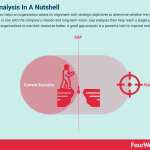
A gap analysis helps an organization assess its alignment with strategic objectives to determine whether the current execution is in line with the company’s mission and long-term vision. Gap analyses then help reach a target performance by assisting organizations to use their resources better. A good gap analysis is a powerful tool to improve execution.
Gap analysis to structure an effective action plan
Gap analyses also help to assess how in line is the company’s organization vs. the action plan defined in the stage of planning. Thus, helping reach target goals given the current state. The gap between the target objectives and the current state needs to be broken down in steps, small enough to be executable and measurable.
Gap analysis to identify focus areas
Gap analyses also help to identify focus areas and simplify the execution strategy. Indeed, while business planning tends to complicate things, a gap analysis is useful to identify a few key areas of interest for the upcoming strategy initiatives.
Gap analysis and process improvement
Gap analyses also help with improvement in business processes. Indeed, gap analyses can help identify organizational inefficiencies thus identify quality management processes such as Lean, Scrum, Kaizen, or Six Sigma.
Gap analysis and KPIs
The gap analysis starts also by determining a future state the company is envisioning, which can follow several principles, and in general, that needs to be ambitious yet reachable, measurable, and breakable.
Gap Analysis Frameworks & Tools
[image error]Porter’s Five Forces is a model that helps organizations to gain a better understanding of their industries and competition. Published for the first time by Professor Michael Porter in his book “Competitive Strategy” in the 1980s. The model breaks down industries and markets by analyzing them through five forces
Read: Porter’s Five Forces Framework
[image error]A SWOT Analysis is a framework used for evaluating the business’s Strengths, Weaknesses, Opportunities, and Threats. It can aid in identifying the problematic areas of your business so that you can maximize your opportunities. It will also alert you to the challenges your organization might face in the future.
Read: SWOT Analysis
[image error]The PESTEL analysis is a framework that can help marketers assess whether macro-economic factors are affecting an organization. This is a critical step that helps organizations identify potential threats and weaknesses that can be used in other frameworks such as SWOT or to gain a broader and better understanding of the overall marketing environment.
Read: PESTEL Analysis
[image error]You can use the Ansoff Matrix as a strategic framework to understand what growth strategy is more suited based on the market context. Developed by mathematician and business manager Igor Ansoff, it assumes a growth strategy can be derived by whether the market is new or existing, and the product is new or existing.
Read: Ansoff Matrix
[image error]In the FourWeekMBA growth matrix, you can apply growth for existing customers by tackling the same problems (gain mode). Or by tackling existing problems, for new customers (expand mode). Or by tackling new problems for existing customers (extend mode). Or perhaps by tackling whole new problems for new customers (reinvent mode).
Read: Growth Matrix
The post Gap Analysis In A Nutshell appeared first on FourWeekMBA.



